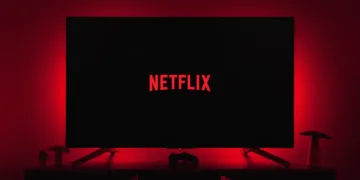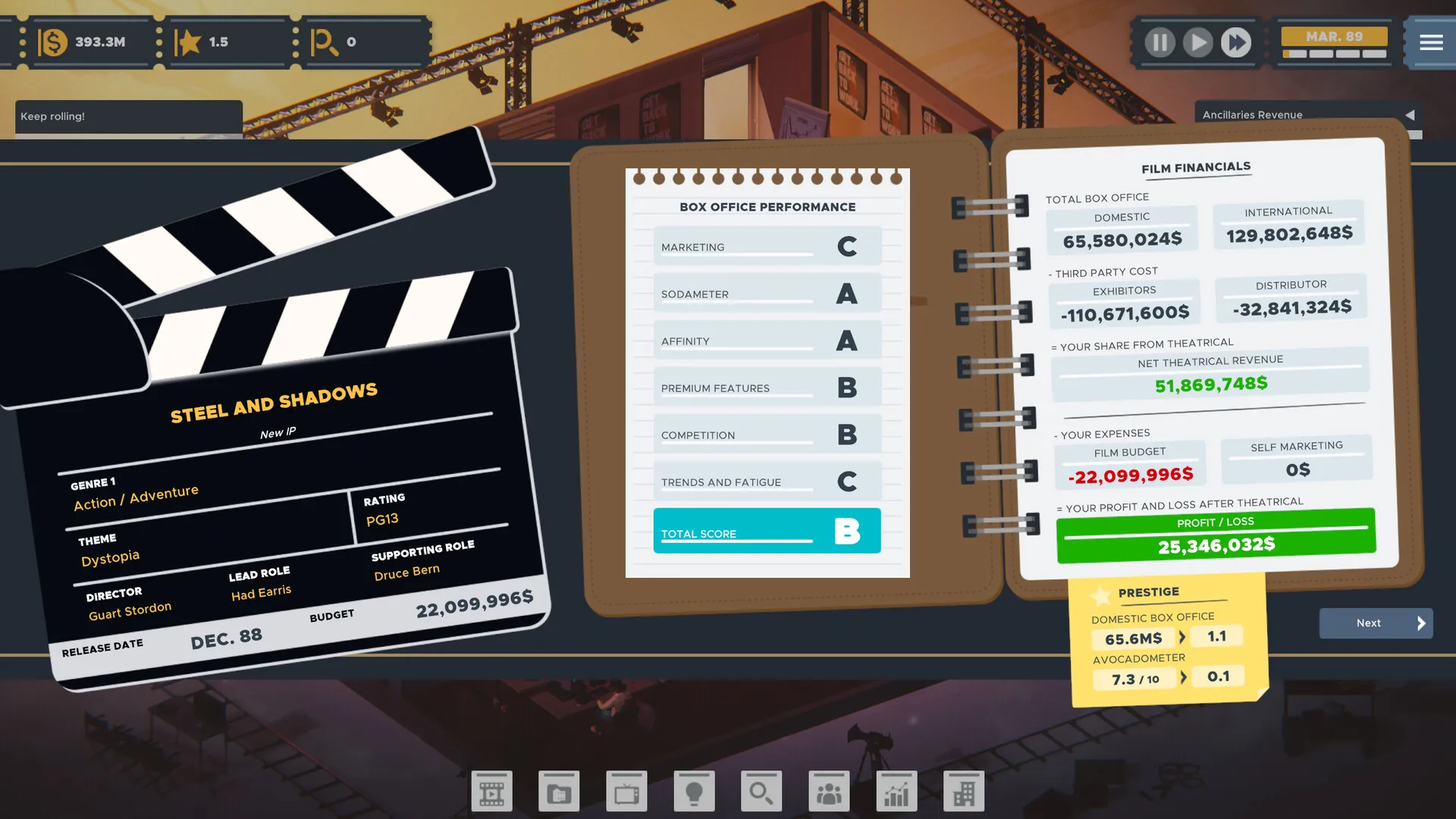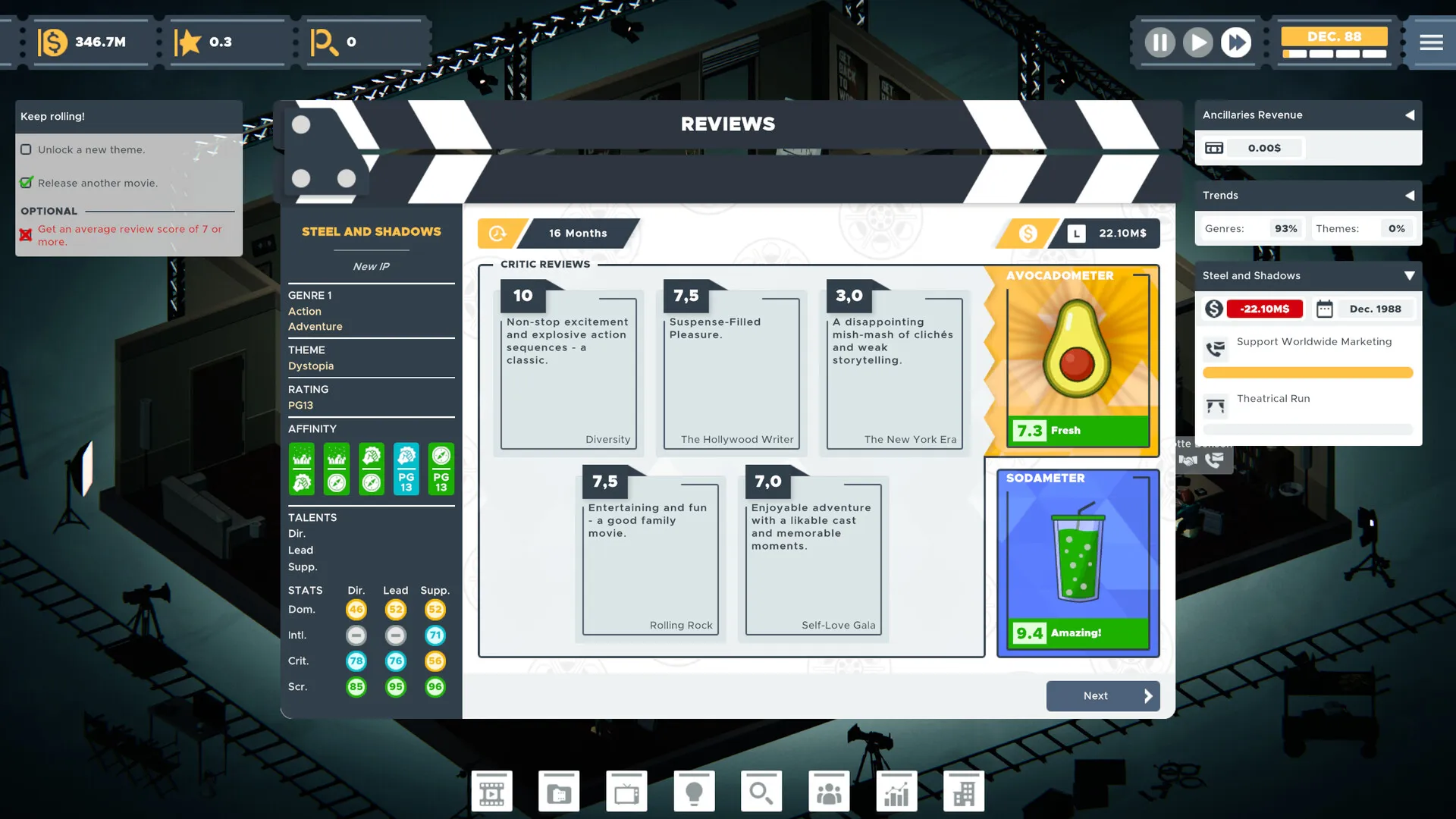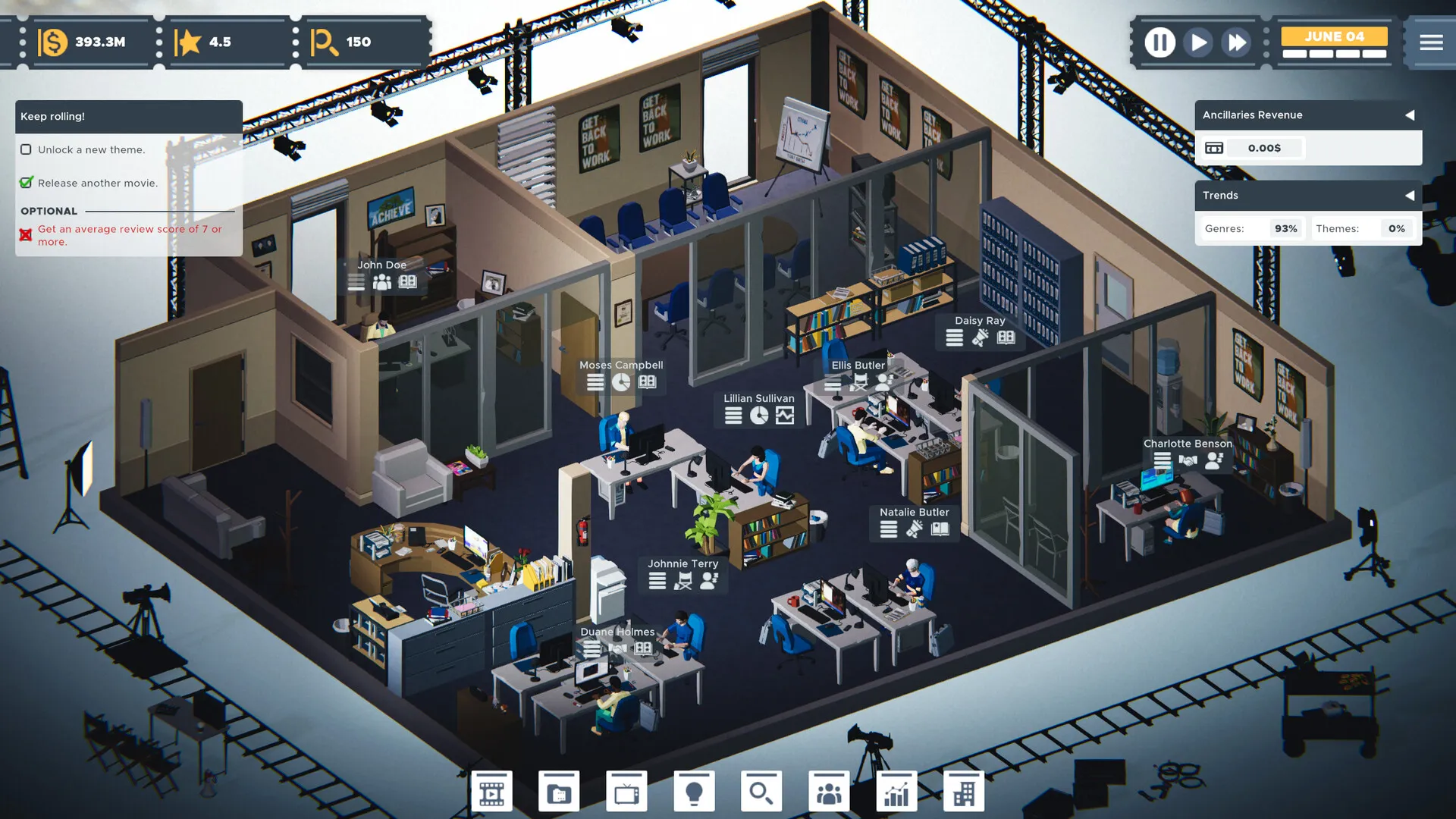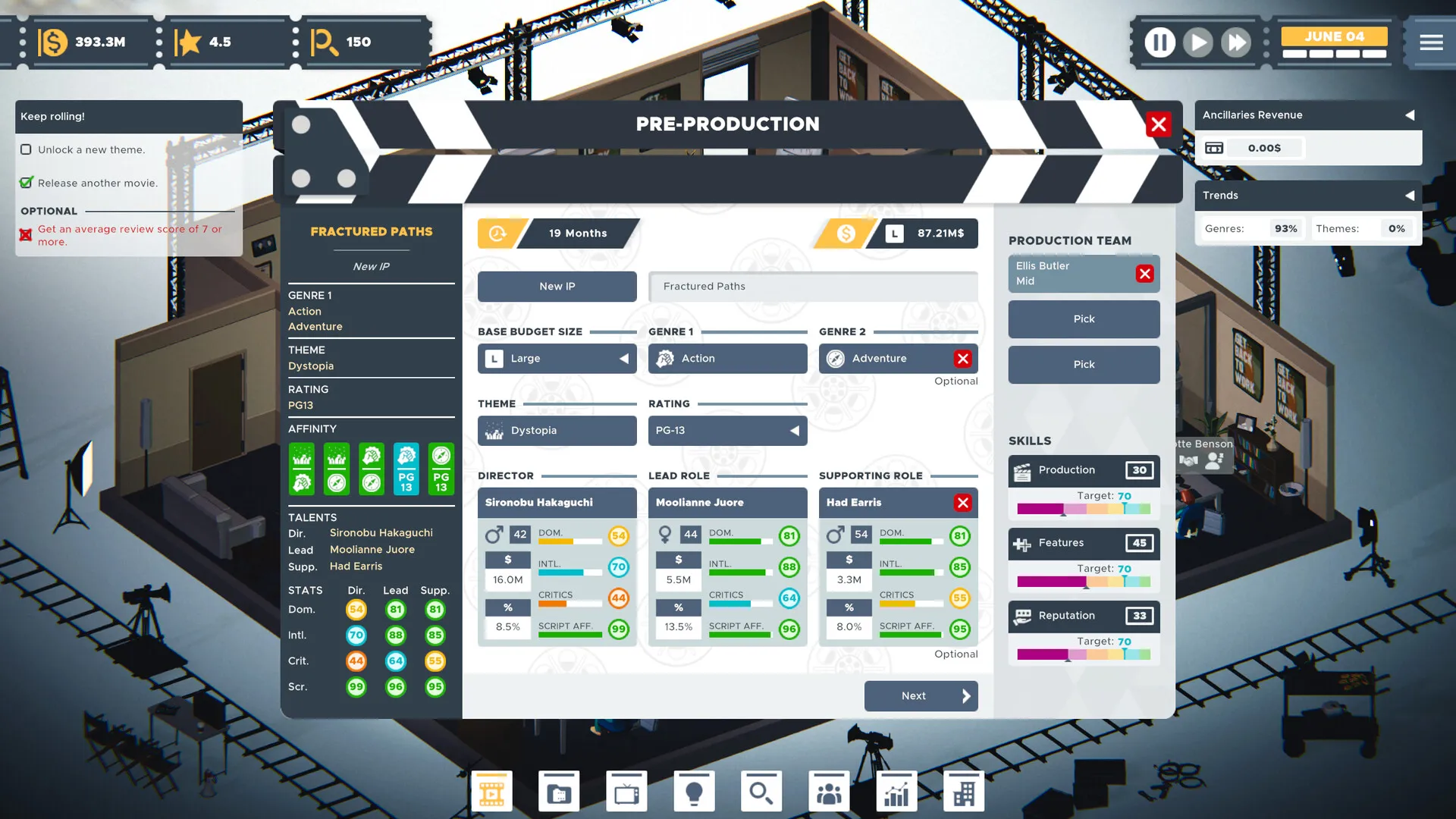The game introduces you as a budding movie studio CEO tasked with constructing a film empire from scratch. Beginning in 1970, the experience unfolds over several decades, painting a picture of the evolving movie industry.
Starting in a modest workspace, you face the dual challenge of crafting films while managing the growth of your enterprise. Your role involves decisions from choosing a film’s genre and theme to organizing budgets and hiring essential team members.
The narrative spark is found in the ambition to produce memorable films that capture audience emotions. The storyline contrasts modest origins with a grand vision of a renowned studio, where each production reflects the influence of historical milestones. Every decision carries the weight of shaping your cinematic legacy and influencing the path of your studio’s progress.
Key gameplay objectives revolve around producing successful films through careful planning across multiple stages. Each film requires attention to pre-production details, careful resource distribution during production, and efficient planning in post-production.
This framework invites you to experience both the creative and managerial sides of film-making, prompting reflections on the nature of ambition and success in the cinematic world.
Behind the Curtain: The Mechanics of Movie Magic
In the early stage of planning a film, you start with the essential choices that shape your production. The game invites you to select a movie title, genre, theme, and age rating. This initial phase is where you decide on the character of your upcoming film.
The player begins alone, handling every task from writing the script to setting the production gears in motion. You then choose directors and lead actors, weighing factors such as box office appeal, compatibility with the script, and salary costs. This decision-making process sets the tone for the creative journey ahead.
Moving into the production phase, the budgeting system comes to the forefront. You allocate funds among various elements such as writing, costume design, and set construction. The slider mechanics allow precise control over the effort applied to each part of the production, which plays a key role in determining the final quality of your movie.
Alongside the standard allocations, there are premium features available. These options, such as special effects, fight choreography, or period-specific costumes, unlock as you progress, offering an extra twist to your project. Each premium element requires certain conditions to be met, adding layers of strategy to your financial planning.
After filming, the focus shifts to the post-production stage. Here, you divide your remaining budget among tasks like editing, special effects enhancement, and sound design. The choices made during this phase can significantly influence how well your film is received.
Finally, the game presents several distribution options. In the beginning, you rely on third-party domestic deals, but as your studio grows, you have the opportunity to explore self-distribution methods. Each stage of production works together to build a complete film-making experience that is both thoughtful and engaging, leaving you to wonder how small changes can alter the overall result.
Scaling Up: From a Cluttered Office to a Studio Empire
The early days find you operating out of a cramped workspace, a setting that underscores the challenge of building a film studio from scratch. As you earn revenue from your initial productions, the small office gradually transforms into a more spacious and functional headquarters.
Improvements in the work environment not only boost efficiency but also signal a growing reputation in the movie business. Alongside this physical growth, new divisions open up—departments focused on marketing and research emerge, each adding practical benefits and strategic depth to your operations.
A key aspect of this evolution is the transition from a one-person team to a diverse group of professionals. Initially, you handle every task, but soon you start recruiting specialists like producers, analysts, and marketing experts. Every hiring decision involves a careful check of your budget and the skills each candidate brings.
The performance of these team members plays a significant role in the success of your film projects, affecting both the creative process and the financial outcome. This shift from sole proprietorship to a well-oiled team not only enhances production quality but also adds a new layer of strategy to the game.
Your growing studio eventually ventures into broader distribution channels. Early on, you rely on third-party domestic deals to release your films, but as your studio gains clout, opportunities for self-managed distribution and international partnerships arise.
Unlocking ancillary revenue through back catalogue exploitation becomes a vital strategy for maintaining cash flow and meeting financial obligations. These evolving dynamics compel you to balance creative risk with sound financial planning, leaving one to ponder the unpredictable nature of success in the film industry.
Behind the Scenes: The Engine of Innovation
The game introduces a system where progress in film production and critical evaluation generates research points. These points serve as a resource for unlocking fresh movie themes, additional genres, and special production options that can alter your film’s style.
Earning these points through careful execution of production tasks and attentive review analysis encourages a thoughtful approach to future projects. The research system subtly reshapes your strategic decisions by offering new capabilities that influence both the creative output and operational effectiveness of your studio.
Decisions on resource distribution become a key part of the experience. You face choices on how much to invest in the narrative and production aspects versus the overall growth of the studio. Choosing between enhancing script quality or boosting special effects capacity adds layers to the decision process.
Detailed performance reports from previous films provide insights that help adjust future investments. This element of the game prompts a reflection on the trade-offs between artistic vision and operational scale, leaving you to consider how best to allocate your limited funds to generate a more compelling final product.
Random events such as unexpected issues with key cast members or production mishaps inject an element of unpredictability. Changes in audience interests and shifts in market behavior require quick reassessment of your current strategies. The timing of releases—whether a film debuts during a busy season or in a quieter period—has a significant impact on financial returns.
These challenges force you to continually evaluate the effectiveness of your choices, both in the immediate aftermath and for long-term studio development. This strategic layer introduces a dynamic tension in planning, prompting thoughts on how a few pivotal decisions might transform your cinematic output.
Visual Presentation & User Interface
The game uses a system of menus, spreadsheets, and sliders to structure the entire experience. The layout is clear, with a straightforward design that lets players find the options they need without confusion.
The production interface is designed with practicality in mind; while the absence of flashy visual cues might seem plain, it reinforces the focus on decision-making over aesthetics.
The office environment is represented by a static backdrop that remains largely unchanged during film production. This simple art style stands apart from more detailed simulations found in similar titles, emphasizing function rather than elaborate design.
The minimal animation means that most attention is given to the numerical and textual data rather than dynamic visuals. This approach has its advantages, offering a clean view of available options, though it might leave some players wishing for a bit more visual excitement during key moments.
Data is presented in a series of production reports, performance reviews, and box office charts. The feedback system delivers important figures in a format that is easy to interpret, helping players understand how well their films perform and what adjustments might be necessary for future projects.
There is potential for improvement in the visual engagement of these reports; a more interactive or visually rich presentation could enhance the overall experience.
This aspect of the design raises the question of whether adding subtle animations or more detailed graphics during data review would create a deeper connection between the strategic choices and their outcomes.
Balancing Acts: Tension, Variety, and Replay Value
The cycle of film production, review, and analysis serves as the backbone of this experience, setting a rhythm that can quickly feel predictable. The repeated pattern of scripting, budgeting, filming, and post-production creates a routine that is both comforting and potentially wearing after many cycles.
Each iteration offers the chance to refine techniques and adjust strategies based on past performance, yet the constant repetition may lead to fatigue for players who crave fresh challenges during each play session.
Unexpected events introduce an element of uncertainty that keeps the pace lively. Random shifts in market trends, sudden mishaps with key talent, and unforeseen production setbacks inject moments of surprise that break the predictable cycle.
These moments encourage quick thinking and add a sense of risk to decisions that might otherwise follow a safe formula. Balancing a methodical production process with the occasional twist demands a keen eye for timing and an ability to adjust plans on the fly.
The game presents options for continued play, including an endless mode and a final scoring system set in January 2020. These alternatives allow players to experiment with different approaches, varying their strategies from risk-averse tactics to daring gambles.
Such flexibility offers a playground for both casual participants and those seeking a deeper strategic challenge. The interplay between routine and randomness leaves one pondering whether a slight shift in tactics might transform a routine production cycle into an electrifying success story.
The Review
The Executive - Movie Industry Tycoon
The Executive delivers a thoughtful simulation experience where strategic decisions and narrative elements intertwine well, despite its cyclical gameplay and understated visuals. It rewards careful planning and adaptability, though the routine nature may test the patience of some players. The game stands out as a solid entry in the simulation genre, particularly for those who appreciate a detailed managerial challenge in the film industry.
PROS
- Engaging film studio management mechanics
- Detailed budgeting and production controls
- Strategic gameplay that rewards careful planning
CONS
- Repetitive production cycle
- Minimal visual flair with limited animations
- Formulaic structure may lower long-term excitement


















